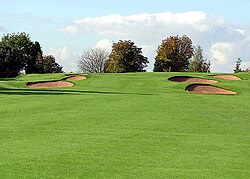User:Mdsimson3/sandbox

Golf course turf is the grass covering golf courses, which is used as a playing surface in the sport of golf. The grass is carefully maintained by a greenskeeper to control weeds, insects and to introduce nutrients such as nitrogen fertilization. The grass is kept at a constant height by mowing.
Nutrient management
[edit]Nitrogen application timing
[edit]Nitrogen is the nutrient required in greatest amount by turfgrass[1]. During an autumn season, rates of nitrogen (N) application should be lowered to consider previous application’s residual available nitrate (NO3−) and mineralization (inorganic N), especially if there is substantial organic matter which releases its supply of sequestered N[2]
In the spring, heavy nitogren applications for the first two months caused changes in color, but the nitrogen response by the grass was not maintained and a decrease in color was found as the growing season progressed. Spring fertilization can increase the tiller numbers of the grass compared to fall fertilization[3].
In the fall, application of nitrogen fertilizer caused improved color retention and early spring coloration[3]. Year-to-year differences in nitrogen loss during the fall result from differences in temperature and precipitation. Lower levels of nitrogen loss during fall were found when it was warmer (more plant uptake) and dryer (less loss due to leaching) [2].
The quality and color of turf will increase[clarification needed] with nitogen application amount. Both of the high rates created darker green turf throughout the duration of the experiment. There is a positive correlation between high levels of nitrogen fertilizer used on turf and turf quality for any level of wear[4].
Environmental quality
[edit]Groundwater and air quality should be considered when applying fertilizer and pesticides to turf.
Fate of nitrogen
[edit]Turf growth at the time of nitogen application has an impact on nitrate (NO3) leaching risk. For example, grass uptook more N during active growth while uptake was limited in newly seeded turf[3]. In another study, nitrogen applied after 15 September (of an northern-hemisphere autumn) caused relatively little plant growth, resulting in increased NO3 - N concentration in percolate water[2]
Areas made of sod undergo greater leaching than seeded turf plots.[5] They attributed these differences to less root development in sod which resulted in less uptake of N by the plants. They also found that deep- rather than shallow-rooted grasses absorbed nitrogen more effectively. Additionally, the authors found that nitrogen uptake for loamy sand was greater than a sandy loam because the turf rooting systems were denser in the loam sand.
A highly soluble fertilizer, containing nitrogen in its nitrate form, such as ammonium nitrate, can create leaching three to seven times greater than United States Environmental Protection Agency limits of (10 ppm) NO3-N during a time of ten to twenty-five days following nitrogen application[6]. Hummel and Waddington, 2001, found that a slow release nitogen fertilizer application could provide nitogen over a long duration and keep nitogen leaching and volatilization[clarification needed] losses to a minimum.[7] A further study demonstrated that after fertilizer application, nitrogen losses exceeded United States Environmental Protection Agency (EPA) limits.[6]
Photoperiod (the length of daylight) affects overall plant uptake. When the length of daylight gets shorter, grass undergoes less photosynthesis and uptakes less nitrogen[8]. To prepare the surface for the following year, high levels of nitrogen application need to be undertaken at the end of the growing season (such as the southern United States[clarification needed]) and increase the risk of nitrate leaching. For example, greater water percolate concentrations of NO3 - N resulted from a late autumn application programme during a New England experiment[2]
See also
[edit]- Golf course, design and terminology
References
[edit]- ^ Turgeon, A.J. (1991). Turfgrass management (3rd ed.). New Jersey: Prentice Hall Regents.
- ^ a b c d Mangiafico, S. (2006). "Fall fertilization timing effects on nitrate leaching and turfgrass color and growth". Journal of Environmental Quality. 35 (1): 163–171. doi:10.2134/jeq2005.0061. PMID 16391287.
((cite journal)): Unknown parameter|coauthors=ignored (|author=suggested) (help) - ^ a b c Oral, N. (2001). "Effects of nitrogen application timing on growth and quality of a turfgrass mixture". Journal of :Plant Nutrition. 24 (1): 101–109. doi:10.1081/PLN-100000315.
((cite journal)): Unknown parameter|coauthors=ignored (|author=suggested) (help) - ^ Bilgili, U. (2007). "Effect of nitrogen fertilization on quality characteristics of four turf mixture under Different wear treatments". Journal of Plant Nutrition. 30 (7): 1139–1152. doi:10.1080/01904160701394600.
((cite journal)): Unknown parameter|coauthors=ignored (|author=suggested) (help) - ^ Wu, L. (2007). "Nitrate leaching in overseeded bermudagrass fairways". Crop Science. 47(Nov-Dec) (6): 2521–2527. doi:10.2135/cropsci2007.01.0042.
((cite journal)): Unknown parameter|coauthors=ignored (|author=suggested) (help) - ^ a b Synyder, G.H. (1984). "Moisture sensor-controlled irrigation for reducing N leaching in bermudagrass turf". Agronomy Journal. 76(Nov-Dec) (6): 964–969. doi:10.2134/agronj1984.00021962007600060023x.
((cite journal)): Unknown parameter|coauthors=ignored (|author=suggested) (help) - ^ Hummel Jr., N.W. (1981). "Evaluation of slow-release nitrogen losses on 'Baron' Kentucky bluegrass". Soil Science Society of America Journal. 45: 966–970. doi:10.2136/sssaj1981.03615995004500050030x.
((cite journal)): Unknown parameter|coauthors=ignored (|author=suggested) (help) - ^ Quiroga-Garza, H.M. (2001). "Nitrogen uptake and potential leaching losses". Journal of Environmental Quality. 30 (2): 440–448. doi:10.2134/jeq2001.302440x. PMID 11285904.
((cite journal)): More than one of|work=and|journal=specified (help); Unknown parameter|coauthors=ignored (|author=suggested) (help)
Text is available under the CC BY-SA 4.0 license; additional terms may apply.
Images, videos and audio are available under their respective licenses.
